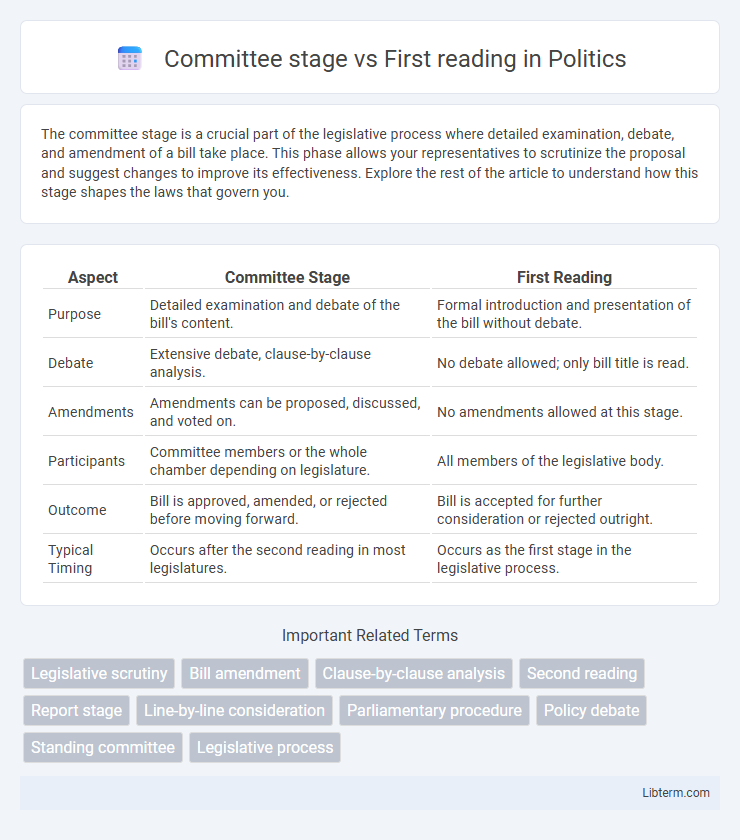The committee stage is a crucial part of the legislative process where detailed examination, debate, and amendment of a bill take place. This phase allows your representatives to scrutinize the proposal and suggest changes to improve its effectiveness. Explore the rest of the article to understand how this stage shapes the laws that govern you.
Table of Comparison
| Aspect | Committee Stage | First Reading |
|---|---|---|
| Purpose | Detailed examination and debate of the bill's content. | Formal introduction and presentation of the bill without debate. |
| Debate | Extensive debate, clause-by-clause analysis. | No debate allowed; only bill title is read. |
| Amendments | Amendments can be proposed, discussed, and voted on. | No amendments allowed at this stage. |
| Participants | Committee members or the whole chamber depending on legislature. | All members of the legislative body. |
| Outcome | Bill is approved, amended, or rejected before moving forward. | Bill is accepted for further consideration or rejected outright. |
| Typical Timing | Occurs after the second reading in most legislatures. | Occurs as the first stage in the legislative process. |
Introduction to Legislative Stages
The First Reading is the initial phase where a bill is formally introduced and its general principles are presented without debate or amendments. The Committee Stage follows, allowing detailed examination, discussion, and modification of the bill's clauses by a committee of members. This stage is crucial for refining legislation before it proceeds to further readings and eventual approval.
Overview of the First Reading
The First Reading in legislative processes serves as the formal introduction of a bill, where its title and main objectives are presented without debate or amendment. This stage allows legislators to familiarize themselves with the bill's purpose before detailed examination occurs. Compared to the Committee Stage, where in-depth analysis, discussion, and modifications take place, the First Reading primarily focuses on notifying members and scheduling further scrutiny.
Purpose and Process of First Reading
The First Reading in legislative procedure serves the primary purpose of introducing a bill to the parliament, presenting its title and main objectives without detailed debate. During this stage, members receive the text of the bill, allowing initial consideration and scheduling for subsequent discussions. Unlike the Committee Stage, which involves detailed examination and amendment, the First Reading is a formal step to ensure transparency and initiate the legislative process.
Committee Stage Explained
The Committee Stage in the legislative process involves detailed examination, debate, and amendment of the bill's clauses by a smaller group of legislators, unlike the First Reading, which serves primarily as an introduction without debate. During Committee Stage, members analyze specific provisions, suggest modifications, and ensure thorough scrutiny to improve the bill's content and address concerns raised in earlier stages. This stage is crucial for refining legislation before it proceeds to further readings and potential enactment.
Key Differences: First Reading vs Committee Stage
The First Reading in the legislative process is primarily a formal introduction of a bill, emphasizing its title and general purpose without debate or detailed examination. In contrast, the Committee Stage involves a thorough line-by-line analysis, allowing members to debate, amend, and scrutinize the bill's specific provisions. This stage is critical for refining legislation and addressing potential issues before moving forward in the parliamentary process.
Roles of Members in Each Stage
During the First Reading, members primarily focus on the formal introduction and initial consideration of the bill, with limited debate and no amendments allowed. At the Committee Stage, members play an active role in scrutinizing the bill's details, proposing, debating, and voting on amendments to refine the legislation. This stage enables members to engage deeply with the bill's content, influencing its final form before further parliamentary consideration.
Amendments and Debates: Committee Stage Focus
In the Committee stage, detailed examination of the bill occurs with a strong emphasis on debating specific clauses and proposing amendments to refine the legislation. Members analyze the content line by line, allowing for substantive changes and clarifications based on expert input and stakeholder feedback. This contrasts with the First Reading, which is primarily a formal introduction without debate or amendments.
Importance of Public Participation
Public participation during the Committee stage is crucial as it allows stakeholders to provide detailed feedback, influence amendments, and ensure transparency in the legislative process. Unlike the First Reading, which primarily serves as a formal introduction of the bill without debate, the Committee stage enables extensive public input and scrutiny. Engaging citizens at this phase strengthens democratic accountability and enhances the quality of legislation.
Impact on Bill Progression
The First Reading marks the initial introduction of a bill, presenting its title and allowing members to consider its general principles without debate. The Committee Stage involves detailed examination, debate, and amendment of the bill's clauses, significantly shaping its content and prospects for passage. Effective scrutiny during the Committee Stage often accelerates or impedes bill progression by addressing potential issues early and refining legislative intent.
Conclusion: Significance of Both Stages
The First Reading formally introduces a bill, allowing legislators to review its purpose without debate, establishing the foundation for parliamentary consideration. The Committee Stage provides a detailed examination, enabling amendments and expert input to refine the bill's content and ensure legislative precision. Both stages are critical, with the First Reading setting the agenda and the Committee Stage enhancing the bill's quality and democratic legitimacy.
Committee stage Infographic

 libterm.com
libterm.com